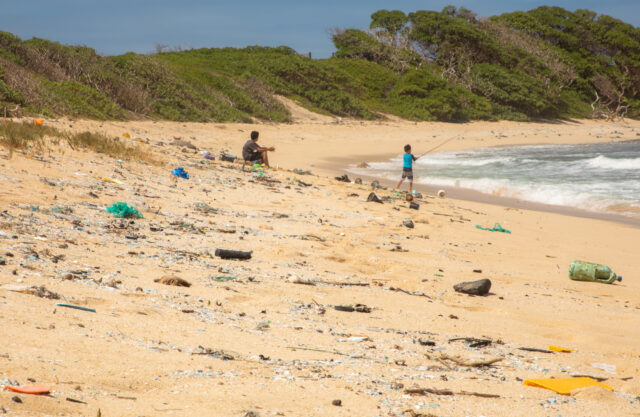5 Ways We Can Move Away From Single-Use Plastics
The pandemic is putting even more plastic into our oceans. But we can change that.
January 18, 2021 · 8 min read

About the Author
There is no doubt that single-use plastics pose a serious threat to the well-being of communities and ecosystems around the world. If the status quo remains, by 2050 there will be , and 20% of fossil fuel will be used to make plastic, exacerbating global carbon emissions.

This reality is no less true in Hawaii, where our shorelines are covered in plastic. At least 220 tons of plastic — equivalent to the weight of 15 school buses — is removed from Hawaii’s shores each year.
This incredible effort, which every year costs over $1 million in volunteer hours and coordination, only scratches the surface of what washes up or sinks into the depths of the ocean. It barely begins to account for the astonishing amount of microplastic particles that contaminate our sand.
There is also no doubt that COVID-19 is dealing a serious blow to Hawaii and the world. As with any crisis, it has been imperative that we focus our attention and respond.
What we know now is that plastic pollution has worsened during the pandemic, brought on by a boom in the use of disposable plastic items like food takeout containers and PPE.В One that 129 billion disposable masks and 65 billion gloves are being used each month around the world. A significant portion of these are winding up in the sea.

In an emergency, it is easy to lose sight of other things that matter — to let other efforts unravel or sit on the back burner. But as we begin to rebuild our social and economic health, we have an incredible opportunity to create a resilient, equitable and healthy future for Hawaii.
When it comes to plastic, the good news is that we have already started. In recent years, all of Hawaii’s major counties have passed important laws to curb our over-reliance on single-use plastics, including a statewide ban on plastic bags.
Around this time last year, another key change began to happen when Honolulu’s mayor signed Bill 40 into law to become Disposable Foodware Ordinance 19-30. The ordinance, recognized as one of the strongest and most comprehensive plastic reduction policies to emerge in any state, phases single-use plastics out of the food service sector and replaces them with compostable items designed to break down into natural components.
Bill 40’s passage was the culmination of 10 years of community effort and further proof that Hawaii is ready to change when it comes to single-use plastics.
But COVID-19 has thrown a wrench into its enforcement. Citing economic fallout from the pandemic, the Hawaii Restaurant Association has announced that it will push to exempt the entire restaurant industry from the ordinance.

It is indisputable that COVID-19 has upended everything. But the truth is that even with the pandemic pushback, we are at a moment when switching away from single-use food service plastic is within reach. Here are five ideas that can help us get there:
1) One simple concept to get us closer to a plastic-free Hawaii is known as “by request only.” BRO means, no surprise, that businesses don’t give you single-use straws and utensils unless you specifically ask for them. Restaurants currently spend thousands of dollars every year giving away disposable utensils, straws and bags to customers who don’t need or even want them.
The BRO rule is built into the structure of Ordinance 19-30, but whether or not the ordinance is enforced, you the consumer have power over this one right now. Tell businesses affirmatively that you don’t want straws and utensils. Bring your own or use what you have at home. This will save our restaurants money and stop waste.
2) Reusable takeout containers work — even in a pandemic — and they are being around the world. A few examples include  in California,  in Portland and  in Switzerland. Some of these programs use stainless steel containers and others use reusable BPA-free plastic (which, although still plastic, decreases pollution and climate impacts associated with single-use plastics).
The key is consistency and using containers that can be sanitized before reuse. Zero Waste Oahu isВ called Full Cycle TakeoutВ on the North Shore of Oahu this year to show how reusable takeout containers would work locally. The containers for the Full Cycle program have been approved by the Hawaii Department of Health.
3) Hundreds of restaurants and food trucks across Hawaii have already weeded out single-use plastics. Many of these businesses, most of them small and locally owned, grew successfully in the process, disproving the theory that ditching single-use plastics would drive them under.
The certifies and lists local restaurants that have already switched away from single-use plastic. During the pandemic, we have even seen small businesses like Protea Zero Waste and Keep It Simple Kaimuki open their doors. Their business models are designed around ethical, plastic-free retail. Supporting all of these businesses reduces plastic in the waste stream.

4) We can use COVID-19 recovery stimulus funding to invest in infrastructure to support a zero-waste future. These projects include building composting facilities that will break down both compostable food packaging and food waste.
Compostable items are made from different materials, including corn, bagasse, banana leaves and . Decomposition of these items can take anywhere from several weeks to a few months depending on the materials and conditions — drastically better than the centuries it takes plastic to break down.
But while compostables are better, they still have an impact and should be used judiciously. Bio-plastics can pose risks to marine life when not properly disposed of. We must continue to improve compostable materials so they break down as easily and safely as possible.
5) We can push Honolulu’s city and county government to enforce Disposable Foodware Ordinance 19-30.
HRA’s position is not new. The industry group has argued for a decade that it is cost-prohibitive for Hawaii’s restaurants to switch from plastics to compostables. In 2017, for example, the HRA and the Hawaii Food Industry Association held that Bill 71 (a ban on polystyrene foam containers) would lead to devastating economic losses and restaurant closures throughout the food service industry.
Ironically, the most stalwart opponents to the change are a few large restaurants and established chains (including McDonald’s, 7-Eleven and Zippy’s) that undoubtedly have the resources to take the lead in ditching plastics.
To understand how much money we are talking about here: The price difference between a plastic utensil and a compostable one is currently about 3 cents.

The price difference between a polystyrene container and a compostable container is currently about 10 to 15 cents.
If a customer declines utensils (which cost about 18 cents total for a compostable fork, knife and spoon), that more than makes up for the 15 cent difference in cost betweenВ a polystyrene and a compostable container.
We also know from testimony for Bill 40 that many local customers are willing to pay more for compostables, part of a , especially among millennials, who would not balk at paying 25 cents more to do better by our environment.
The more widespread the use of compostables becomes, the lower their price will go because their manufacturing will scale way up. And let’s not forget that plastic is artificially cheap.
According to the , in 2017 U.S. subsidies to the fossil fuel industry were estimated at $5.2 trillion, or about 6.5% of the GDP. Artificially cheap oil and gas make for cheap plastic and further contribute to the climate crisis.
We could ask: What if we subsidized plant-derived compostable products instead?
Share Your Ideas
To submit an essay or if you just want to talk over an idea, contact:
IDEAS Editor Julia Steele
jsteele@civilbeat.org
Plastic packaging alone creates an estimated , including ocean pollution, toxic accumulation in our food chain and animal ingestion of, or entanglement in, plastic. Most of these costs are shouldered by taxpayers and NGOs and are not reflected in the price of plastic.
If we factored in these costs as well as our local expenditures on incinerators, landfills and plastic pollution removal, would plastic still seem so cheap?

COVID-19 is forcing us to reexamine all of our systems. Even before the pandemic, we in Hawaii were examining — and tackling — single-use plastic. Our innovation is needed now more than ever.
 Sign up for our FREE morning newsletter and face each day more informed.
Sign up for our FREE morning newsletter and face each day more informed.
Read this next:
Eric Stinton: What Hawaii Can Learn From The Trump Years
By Eric Stinton · January 19, 2021 · 6 min read
Local reporting when you need it most
Support timely, accurate, independent journalism.
МмГАКУЖµ is a nonprofit organization, and your donation helps us produce local reporting that serves all of Hawaii.
ContributeAbout the Author
Nicole Chatterson is the co-founder and executive director of Zero Waste Oahu. She has spent the past 13 years working on solutions to plastic pollution in Hawaii and the Pacific Ocean.
Latest Comments (0)
Grow hemp, make biodegradable containers.
Village · 4 years ago
Let's all do our part and also encourage food manufacturers to do theirs as well.В I was munching on a treat of WheatВ Thins the other day, and as I was unfolding the plastic bag I recalled a time when they were in a wax paper bag in a cardboard box.В Just like the Ritz cracker sleeves.В I understand the necessity for food safety, but there ought to be some compromise that can be reached.В How do we start this discussion?В
jledesma · 4 years ago
Like most things, the only practical way to move away from something at a meaningful scale is to have a better and cheaper alternative.
justsaying · 4 years ago
About IDEAS
IDEAS is the place you'll find essays, analysis and opinion on public affairs in Hawaii. We want to showcase smart ideas about the future of Hawaii, from the state's sharpest thinkers, to stretch our collective thinking about a problem or an issue. Email news@civilbeat.org to submit an idea.


